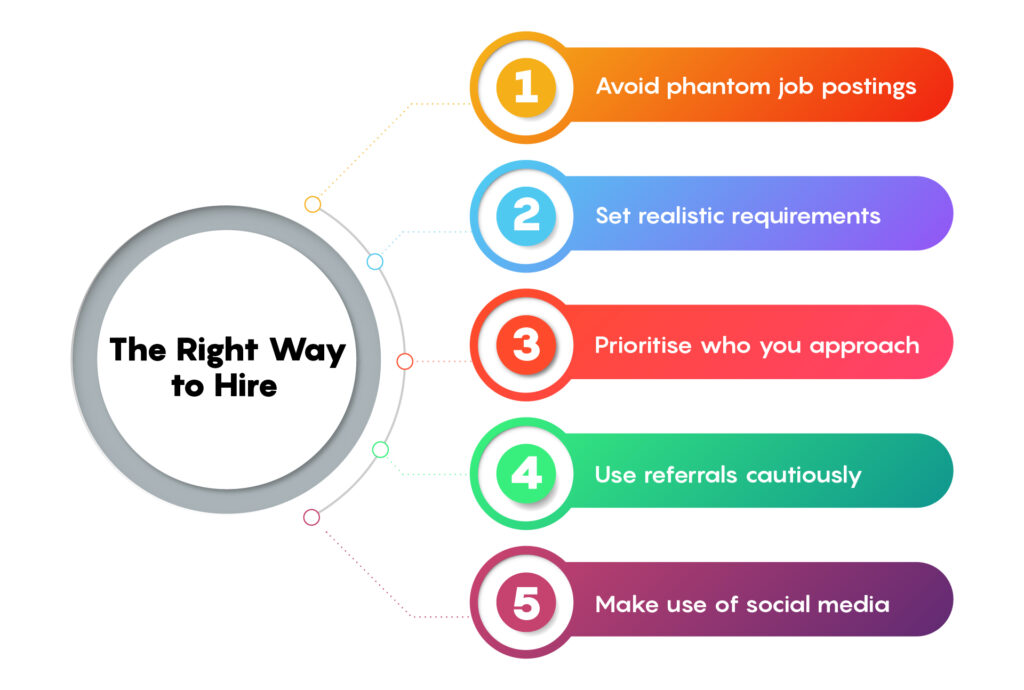The very nature of hiring and recruitment has changed over the years. In the past, people used to approach companies and seek out job openings. Nowadays, businesses are the ones doing the hunting as they search for the right candidate to fill the role. You need to understand that it is not just the company giving employees a chance to learn and grow their careers. They are also giving your business something invaluable – a much-needed skill set and labour.
How Do You Define Recruitment?
It is the process of identifying a specific role in the organisation and using a set of techniques to identify, attract and select skilled individuals to fill that job role. Every organisation has a unique hiring process that can vary in style as well as size depending on the scale of the company. A larger company may have an entire recruitment team at its disposal to get the job done, whereas a smaller business might have just one person working as a recruiter.
In some instances, organisations might also outsource the responsibility to external recruiting agencies. Whatever the path you might choose for your business, keep in mind that recruiting typically goes hand-in-hand with the Human Resources (HR) department.

The Role Of Human Resources Management (HRM) In Recruitment
The role of the HR department in the recruiting process amounts to the handling of interviews, placements and selection of candidates. What that basically means is, the HR places a lot of importance on employees and sees them as the company’s most valuable asset. Quite often the HR team will work in tandem with the top management to decide on hiring policies and the type of work culture that will be given to new employees.
The HR acts as a mediator and tries to find a middle ground that will suit the company while also benefiting the employees to give them an ideal work environment.
‘‘
A well-organised HR department will really streamline the recruiting and hiring process, so make sure to give that priority when starting out.
When Is The Right Time To Hire?
Recruitment can be a tricky thing. If you take on the hiring process too early then you might not have the funding to pay them a fair wage or it can leave your coffers stretched. On the other hand, if you hire too late your team could fall behind and be overburdened with work. It is a tight-rope-walk activity and you have to find the right balance. Here are some signs that it is time to hire:
- You have the funds to take on a new employee.
- The existing staff is falling behind on responsibilities despite working long hours.
- Your team is lacking a person with a set of specific skills to get a certain job done and it is holding up the line of work.
- You are forced to outsource more and more of your internal tasks.
- The company is forecasted for rapid growth in the near future and you will most likely have additional positions that need to be filled.
In the case of a start-up, you will be constantly juggling money, time and a large workload, so hiring will have to be a completely instinctual thing at this point. Since all those factors are so rapidly changing during the early stages of the business, you need to use your best judgement in combination with the above-mentioned factors to see if now is the right time for a hire.
Even if you decide to hire later down the road, it always helps to have a Recruitment strategy in place – do it weeks or even months in advance so when the time comes, you maximise your efforts.
Crafting A Solid Job Description
A lot of new companies will try very hard to stand out from the crowd, especially on those job-seeking platforms like LinkedIn. The reason being, there are so many brands, businesses and corporations with similar job descriptions that sound fancy and are sure to attract a lot of candidates for the position.
There is a need to stand out and make your company known. To overcome this hurdle, avoid similar-sounding job descriptions. Since there are so many out there, at a certain point they all start to sound the same and the candidates see it too. Give job seekers something fresh and exciting. There are three main things to include in any job description:
About the company
Sell the brand and the company to candidates. What you do, who you are, the values and mission you have in place. This is where you need to stand out most in the vast ocean of companies trying to recruit. Make it something fresh and interesting. Make a point of emphasising the organisational culture – it will be your identity that helps the business to stand out.
For example, a company that describes its organisational culture as a vibrant and easy-going environment with a fast-paced workflow and with plenty of opportunities for individual growth, is one that candidates will definitely consider.
The job
Rather than listing out a daunting number of pointers on what the candidates will have to do daily, list out the expected output from them. You may also want to include the key skills required, the level of experience the company is looking for and keep it open-ended. Do not state things as if they are set in stone, rather list them as ‘desirable’ to show that even if they do not have those skills, they are still welcome to apply. Throw a wide net and you will be surprised at the level of talent you attract.
Additionally, focus on the type of mindset and work ethic you expect from new employees. This helps set the tone of the work environment.
Benefits and compensation
Start-ups may not be able to pay employees the industry standard from the outset unless they have a tremendous amount of funding. If that is the case, you need to be very clear about that. Even if you do not want to advertise the exact number, candidates will appreciate it if you at least give them a range to work with.
When it comes to benefits, it can be a relatively inexpensive way of showing candidates that the organisation cares about their well-being and that steps have been taken to ensure fun and growth-filled workspace. As they say, “It is the thought that counts.”
Types Of Recruitment
Internal
This type of recruiting fills any openings in the company with the existing pool of talent from within the business. Employees who perform well or want to make a lateral transition and have the skills to do so are great candidates for this.
Retained
Essentially an organisation pays a fee in advance to a recruiting firm and keeps them on retainer till they find a suitable candidate to fill the position. It is also an agreement that the organisation will work exclusively with that firm for that duration of time.
Contingency
This is the same principle as the retained recruiting but in this case, the external recruiting firm is only paid the fees once a suitable candidate is found. In other words, the payment is contingent on the firm’s results.
Staffing
Staffing recruitment focuses on short-term and temporary jobs that are given to candidates on a need-by-need basis. The staffing agency matches up candidates with open positions across various companies and assigns them to whichever one suits best. It works similar to a recruitment firm – the only difference is the duration of work.
Outplacement
When an employee is terminated from an existing position or they wish to transition to a new job, they engage with outplacement services that help them with the job search, resume writing and getting a letter of recommendation and so on. Essentially, it arms them with the resources they need to find a new job.
Reverse
Instead of having candidates apply to companies for a job, this method helps companies apply to the candidate. Usually, it is carried out on a hosting platform and companies are screened and positioned in such a way that it is really easy for candidates to find the right posting. A good example of this is when companies message you on LinkedIn to see if you are open to joining them.

How To Go About The Hiring Process
Avoid phantom job postings
Many times, companies will put up an advertisement for a job opening on their websites or third-party job sites. Once a candidate clicks on that and applies, they spend anywhere from a few days to a few weeks waiting for a response, only to find out it was already filled. Companies usually do this to collect a pool of resumes for future hires but this just leads to a lot of frustrated candidates and a poor reputation for the business.
Set realistic requirements
Everyone wants an all-rounder who can do everything. The reality is most candidates will be skilled in one section and maybe not so much in another. Set requirements that are attainable and narrow so that the quality of skills is present over the quantity. A compact list of requirements also encourages more candidates to apply as it seems less daunting.
‘‘
Keep in mind that above all else, potential applicants want to know as much about the job as possible, so give them all the details upfront. It saves everyone a lot of time.
Prioritise who you approach
Companies spend a lot of time reaching out to individual candidates who have not even applied to a job, based purely on the resume. While this can be beneficial sometimes, this road often leads to wasted efforts. Instead, refocus efforts on the employees you have within the company. Internal candidates have a working knowledge of the organisation and have most likely already undergone lateral growth for a variety of positions. Access this pool of candidates before you start reaching out to find fresh faces.
Use referrals cautiously
While referrals can provide some truly talented individuals it is not always the case. The issue with relying too heavily on referrals is that you have no prior knowledge of that person’s work style or quality. Having said that, referrals are worth considering in the hiring process. You need to have multiple channels to access candidates if you want to fill that position fast. But, do not depend on them blindly.
Make use of social media
Yes, primarily you need to rely on job sites to connect the employer with the candidate but why limit yourself? Get on social media and make the most of it. Social media platforms offer a variety of different options and even have special business accounts that provide analytical data on who sees your posts, when, how often and from where.
You get all the data and a direct line of dialogue with the candidates. If you have the time put in some effort into developing the business’s social channels – you will see amazing results in no time. Companies with an active presence on social media who also readily engage with candidates breed an air of modernity. It shows the general public that you are willing to embrace change and try new things.
Go check out our article on ‘onboarding’ to learn more about hiring and recruitment fits into the bigger picture of getting new employees integrated into the company.




